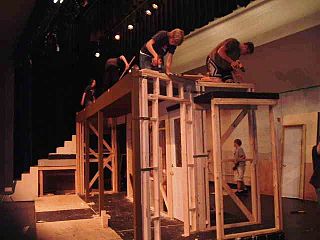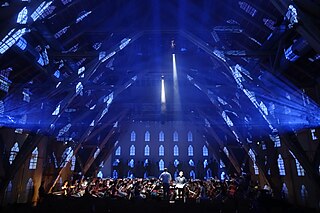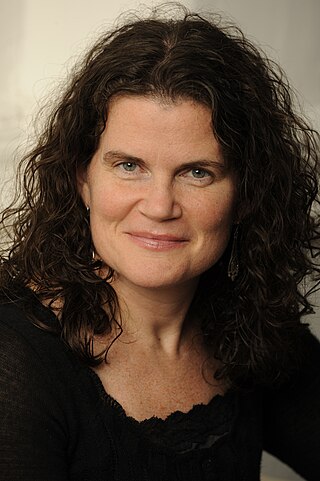A film crew is a group of people, hired by a production company, for the purpose of producing a film or motion picture. The crew is distinguished from the cast, as the cast are understood to be the actors who appear in front of the camera or provide voices for characters in the film. The crew is also separate from the producers, as the producers are the ones who own a portion of either the film studio or the film's intellectual property rights. A film crew is divided into different departments, each of which specializes in a specific aspect of the production. Film crew positions have evolved over the years, spurred by technological change, but many traditional jobs date from the early 20th century and are common across jurisdictions and filmmaking cultures.

Stage management is a broad field that is generally defined as the practice of organization and coordination of an event or theatrical production. Stage management may encompass a variety of activities including overseeing of the rehearsal process and coordinating communications among various production teams and personnel. Stage management requires a general understanding of all aspects of production and provides complete organization to ensure the process runs smoothly and efficiently.
"Below-the-line" is a term derived from the top sheet of a film budget for motion pictures, television programs, industrial films, independent films, student films and documentaries as well as commercials. The "line" in "below-the-line" refers to the separation of production costs between script and story writers, producers, directors, actors, and casting and the rest of the crew, or production team.

Set construction is the process undertaken by a construction manager to build full-scale scenery, as specified by a production designer or art director working in collaboration with the director of a production to create a set for a theatrical, film, or television production. The set designer produces a scale model, scale drawings, paint elevations, and research about props, textures, and so on. Scale drawings typically include a groundplan, elevation, and section of the complete set, as well as more detailed drawings of individual scenic elements which, in theatrical productions, may be static, flown, or built onto scenery wagons. Models and paint elevations are frequently hand-produced, though in recent years, many Production Designers and most commercial theatres have begun producing scale drawings with the aid of computer drafting programs such as AutoCAD or Vectorworks.
In film and television, the production designer is the individual responsible for the overall aesthetic of the story. The production design gives the viewers a sense of the time period, the plot location, and character actions and feelings. Working directly with the director, cinematographer, and producer, production designers have a key creative role in the creation of motion pictures and television. The term production designer was coined by William Cameron Menzies while he was working on the film Gone with the Wind. Production designers are commonly confused with art directors as the roles have similar responsibilities. Production designers decide the visual concept and deal with the many and varied logistics of filmmaking including, schedules, budgets, and staffing. Art directors manage the process of making the visuals, which is done by concept artists, graphic designers, set designers, costume designers, lighting designers, etc. The production designer and the art director lead a team of individuals to assist with the visual component of the film. Depending on the size of the production the rest of the team can include runners, graphic designers, drafts people, props makers, and set builders. Productions Designers create a framework for the visual aesthetic of a project and work in partnership and collaboration with the Set Decorator & Set Decorating department to execute the desired look.

The International Alliance of Theatrical Stage Employees, Moving Picture Technicians, Artists and Allied Crafts of the United States, Its Territories and Canada, known as simply the International Alliance of Theatrical Stage Employees, is a North American labor union representing over 168,000 technicians, artisans, and craftspersons in the entertainment industry, including live theatre, motion picture and television production, broadcast and trade shows in the United States, its territories, and Canada. It was awarded the Tony Honors for Excellence in Theatre in 1993.
The set decorator is the head of the set decoration department in the film and television industry, responsible for selecting, designing, fabricating, and sourcing the "set dressing" elements of each set in a Feature Film, Television, or New Media episode or commercial, in support of the story and characters of the script. The set decorator is responsible for each décor element inside the sets, from practical lighting, technology, art, furniture, drapery, floor coverings, books, collectables, to exterior furnishings such as satellite dishes, Old West water troughs, streetlamps, traffic lights, garden furniture and sculptures.

A stagehand is a person who works backstage or behind the scenes in theatres, film, television, or location performance. Their work include setting up the scenery, lights, sound, props, rigging, and special effects for a production.
Ted LeFevre is an American theatrical set designer.

Boris Aronson was an American scenic designer for Broadway and Yiddish theatre. He won the Tony Award for Scenic Design six times in his career.

The Art Directors Guild is a labor union and local of the International Alliance of Theatrical and Stage Employees (IATSE) representing 3,278 motion picture and television professionals in the United States and Canada.

A costume designer is a person who designs costumes for a film, stage production or television show. The role of the costume designer is to create the characters' outfits or costumes and balance the scenes with texture and colour, etc. The costume designer works alongside the director, scenic, lighting designer, sound designer, and other creative personnel. The costume designer may also collaborate with a hair stylist, wig master, or makeup artist. In European theatre, the role is different, as the theatre designer usually designs both costume and scenic elements.
(Also known as Designer's Guild or B.F.D.G. and can be seen after a member's name as a professional certification abbreviation)
2007 Broadway Stagehands Strike was a strike action by stagehands represented by Theatrical Protective Union Number One of the International Alliance of Theatrical Stage Employees (IATSE) against the Shubert, Jujamcyn, and Nederlander theaters. The strike commenced on November 10, 2007, at 10:00 A.M. in New York City. It was the second strike on Broadway in five years.
Howard Bay was an American scenic, lighting and costume designer for stage, opera and film. He won the Tony Award for Best Scenic Design twice.

Video design or projection design is a creative field of stagecraft. It is concerned with the creation and integration of film, motion graphics and live camera feed into the fields of theatre, opera, dance, fashion shows, concerts and other live events. Video design has only recently gained recognition as a separate creative field. For instance, United Scenic Artists' Local 829, the union representing designers and scenic artists in the US entertainment industry, only added the Global Projection Designer membership category in 2007. Prior to this, the responsibilities of video design would often be taken on by a scenic designer or lighting designer. A person who practices the art of video design is often known as a Video Designer. However, naming conventions vary worldwide, so practitioners may also be credited as Projection Designer, "Media Designer", Cinematographer or Video Director. As a relatively new field of stagecraft, practitioners create their own definitions, rules and techniques.
Jane Greenwood is a British costume designer for the stage, television, film, opera, and dance. Born in Liverpool, England, she works both in England and the United States. She has been nominated for the Tony Award for costume design twenty-one times and won the award for her work on The Little Foxes.

Iosef Yusupov is an American set designer who was one of the scenic designers for the George Tsypin creative team of the 2014 Winter Olympics opening ceremony in Sochi, Russia. Currently living in the United States, he has designed many shows in New York City and has worked motion pictures as a scenic artist. His sets that he builds create an illusion of 3-dimensions, with 2-dimensional material.

Elaine J. McCarthy is an American projection and video designer for theater and opera.










